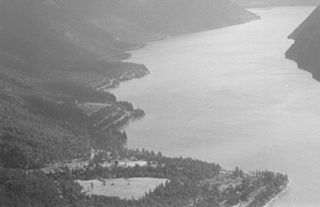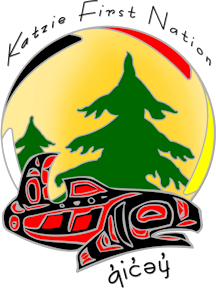Related Research Articles

The Tsilhqotʼin or Chilcotin are a North American tribal government of the Athabaskan-speaking ethnolinguistic group that live in what is now known as British Columbia, Canada. They are the most southern of the Athabaskan-speaking Indigenous peoples in British Columbia.

Stuart River Provincial Park is a provincial park in British Columbia, Canada. It is located in two sections north and northwest of Vanderhoofalong the Stuart River southeast of Stuart Lake and the city of Fort St. James. The upper section is located at 54°13′20″N124°00′00″W and comprises c.7391 ha. while the lower, eastern section is centred at 54°03′00″N123°37′00″W and comprises c.3390 ha. and is within the Greater Prince George area. The upper site, which is located around the confluence of the Stuart and Nechako Rivers, includes the site of Chinlac, a Dakelh village whose inhabitants were massacred and enslaved by the Tsilhqot'in of Anahim Lake c. 1745.
Alexis Creek is an unincorporated community in the Chilcotin District of the western Central Interior of the Canadian province of British Columbia, on Highway 20 between Williams Lake and Bella Coola. The creek is named, like the adjacent lake of the same name, for a colonial-era chief of the Tsilhqot'in people, Alexis, who figured in the story of the Chilcotin War of 1864.
The Lower Similkameen Indian Band or Lower Smelqmix, is a First Nations band government in the Canadian province of British Columbia. Their office is located in the village of Keremeos in the Similkameen region. They are a member of the Okanagan Nation Alliance.
The Williams Lake First Nation is a First Nations government of the Secwepemc (Shuswap) Nation, located in the Cariboo region of the Central Interior region of the Canadian province of British Columbia, at the city of Williams Lake. It was created when the government of the then-Colony of British Columbia established an Indian Reserve system in the 1860s. It is a member government of the Northern Shuswap Tribal Council. Its main Indian Reserve is Williams Lake Indian Reserve No. 1, a.k.a. "Sugarcane" or "The Cane" or "SCB".

The Stswecem'c Xgat'tem First Nation, formerly known as Canoe Creek Band/Dog Creek Indian Band, created as a result of merger of the Canoe Creek Band and Dog Creek Band is a First Nations government of the Secwepemc (Shuswap) Nation, located in the Fraser Canyon-Cariboo region of the Central Interior of the Canadian province of British Columbia. It was created when the government of the then-Colony of British Columbia established an Indian Reserve system in the 1860s. It is a member government of the Northern Shuswap Tribal Council.
The High Bar First Nation is a First Nations government of the Secwepemc (Shuswap) Nation, located in the Fraser Canyon-Cariboo region of the Central Interior of the Canadian province of British Columbia. It was created when the government of the then-Colony of British Columbia established an Indian Reserve system in the 1860s. It is one of three Secwepemc bands that is not a member of either the Shuswap Nation Tribal Council or the Northern Shuswap Tribal Council. The High Bar people are also partly Tsilhqot'in and have links with some Chilcotin First Nations.
The Esk'etemc First Nation, also known as the Alkali Lake Indian Band, is a First Nations government of the Secwepemc (Shuswap) people, located at Alkali Lake in the Cariboo region of the Central Interior of the Canadian province of British Columbia. It was created when the government of the then-Colony of British Columbia established an Indian Reserve system in the 1860s. It is one of three Secwepemc bands that is not a member of either the Shuswap Nation Tribal Council or the Northern Shuswap Tribal Council.
The Kluskus First Nation is the band government of the Lhoosk’uz, a Dakelh people whose main reserve located on the Chilcotin Plateau 130 km west of the city of Quesnel, British Columbia, Canada. The First Nation is a member of the Carrier-Chilcotin Tribal Council, which includes both Tsilhqot'in and Carrier (Dakelh) communities.
The Red Bluff First Nation is a Dakelh First Nations government located in the northern Fraser Canyon region of the Canadian province of British Columbia. It is a member of the Carrier-Chilcotin Tribal Council, which includes both Tsilhqot'in and Carrier (Dakelh) communities.
The Tl'esqox First Nation is a Tsilhqot'in community located west of the Fraser Canyon in the Chilcotin region of the Canadian province of British Columbia. It is a member of the Carrier-Chilcotin Tribal Council, which includes both Tsilhqot'in and Carrier (Dakelh) communities.
The Tŝideldel First Nation is the band government of the Tsi Del Del subgroup of the Tsilhqot'in people, located in the Chilcotin District in the western Central Interior region of the Canadian province of British Columbia. It is a member of the Tsilhqot'in National Government.
The Stone First Nation or Yunesit'in First Nation is a band government of the Yunesit'in subgroup of the Tsilhqot'in people, whose territory is the Chilcotin District in the western Central Interior region of the Canadian province of British Columbia. It is a member of the Tsilhqot'in Tribal Council. The people of the Stone First Nation are known as the Yunesit'in in the Chilcotin language.

The Seton Lake First Nation, a.k.a. the Seton Lake Indian Band, is a First Nations government located in the Central Interior-Fraser Canyon region of the Canadian province of British Columbia. It is a member of the Lillooet Tribal Council, which is the largest grouping of band governments of the St'at'imc people. Other St'at'imc governments include the smaller In-SHUCK-ch Nation on the lower Lillooet River to the southwest, and the independent N'quatqua First Nation at the farther end of Anderson Lake from Seton Portage, which is the location of three of the band's reserve communities.
The Tl'etinqox-t'in are a First Nations people in the Chilcotin District of the Canadian province of British Columbia. They are a subgroup of the Tshilhqot'in people and reside near the community of Alexis Creek, an unincorporated settlement and Indian Reserve community on Highway 20 near Riske Creek.
The Nazko First Nation is a First Nations government of the Dakelh people in the north-central Interior of British Columbia. Its reserves are located around the community of Nazko, British Columbia, which is 120 km west of Quesnel and southwest of Prince George.

The Katzie First Nation or Katzie Nation is the band government of the Katzie people of the Lower Fraser Valley region of British Columbia, Canada.
The Hartley Bay Indian Band, also known as the Hartley Bay First Nation, Hartley Bay Band, Gitga'at Nation and Gitga'at First Nation, is the band government of the Gitga'ata people of Hartley Bay, British Columbia, Canada.

Towdystan is an unincorporated settlement and First Nations community of the Dakelh people located northwest of Charlotte Lake in the western Chilcotin District of the Central Interior of British Columbia, Canada. Located southeast of Anahim Lake, the headquarters of the Ulkatcho First Nation government, it includes Towdystan Lake Indian Reserve No. 3, which is one of the Indian Reserves of the Ulkatcho Nation and is located at 52°17′00″N125°07′00″W. The reserve had a population of 10, down 50% from a 2001 figure of 20.
The Leqʼ a꞉ mel First Nation, formerly known as the Lakahahmen First Nation, is a First Nations band government whose community and offices are located in the area near Deroche, British Columbia, Canada, about 12 kilometres east of the District of Mission. They are a member government of the Sto:lo Nation Chiefs Council, which is one of two tribal councils of the Sto:lo.
References
- ↑ Indian and Northern Affairs Canada - First Nations Detail Archived 2012-03-02 at the Wayback Machine
- ↑ Indian and Northern Affairs Canada listing of Indian Reserves for Tl'etinqox-t'in Government Office Archived 2011-10-05 at the Wayback Machine
- ↑ The Chilcotin War, Mel Rothenburger, 1976
- ↑ Indian and Northern Affairs Canada - Reserves/Settlements/Villages Detail Archived 2011-10-05 at the Wayback Machine
- ↑ "Anahim Indian Reserve 10". BC Geographical Names .
- ↑ "Anahim Indian Reserve 11". BC Geographical Names .
- ↑ "Anahim Indian Reserve 12". BC Geographical Names .
- ↑ "Anahim Indian Reserve 13". BC Geographical Names .
- ↑ "Anahim Indian Reserve 14". BC Geographical Names .
- ↑ "Anahim Indian Reserve 15". BC Geographical Names .
- ↑ "Anahim Indian Reserve 16". BC Geographical Names .
- ↑ "Anahim Indian Reserve 17". BC Geographical Names .
- ↑ "Anahim Indian Reserve 18". BC Geographical Names .
- ↑ "Anahim Indian Reserve 3". BC Geographical Names .
- ↑ "Anahim Indian Reserve 4". BC Geographical Names .
- ↑ "Anahim Indian Reserve 5". BC Geographical Names .
- ↑ "Anahim Indian Reserve 6". BC Geographical Names .
- ↑ "Anahim Indian Reserve 7". BC Geographical Names .
- ↑ "Anahim Indian Reserve 8". BC Geographical Names .
- ↑ "Anahim Indian Reserve 9". BC Geographical Names .
- ↑ "Anahim's Flat Indian Reserve 1". BC Geographical Names .
- ↑ "Anahim's Meadow Indian Reserve 2". BC Geographical Names .
- ↑ "Anahim's Meadow Indian Reserve 2A". BC Geographical Names .